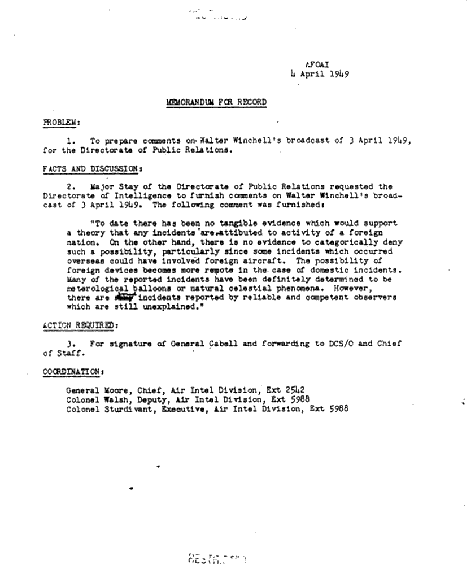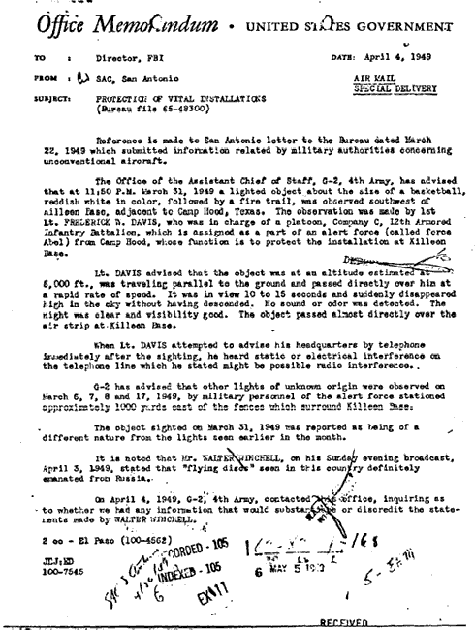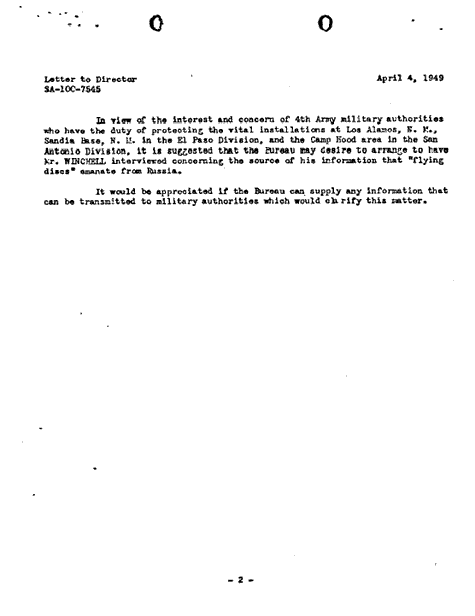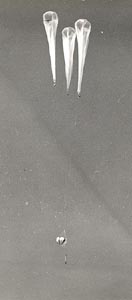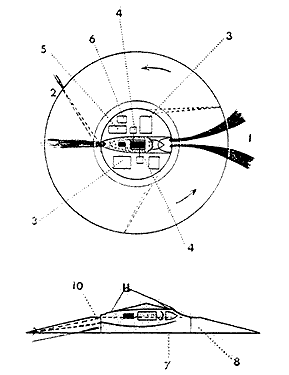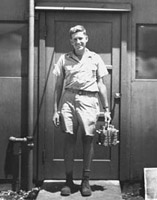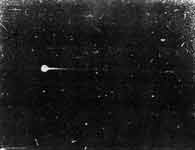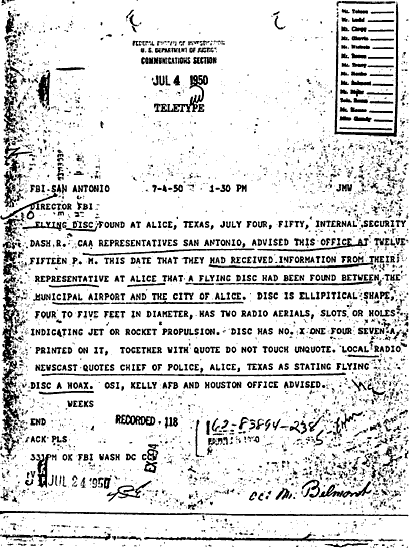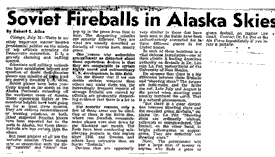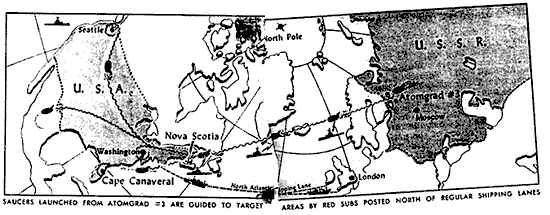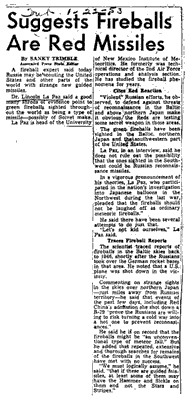The Norton, Kansas Meteorite - A
Factual Statement in the Interest of Safeguarding Research
Part 1
February
18, 1948 at about 5:00 p.m. a fireball was sighted by people of
several states. This was variously reported as a rocket, a bomb, a space
ship, etc.
February
19th. Statements were given to the press by several scientists
including Monning, LaPaz and Nininger, to the effect that a meteorite
had
probably landed in the vicinity of Norton, Kans.
February
19th. Nininger inquired of news agencies if any proposed survey had
been announced by anyone and when informed that no such plan had been
reported, he authorized the announcement that he would be on the way within
an hour to make a survey. The Niningers left about 11:00 a.m. for this
survey the same day.
February
20th was spent in the Panhandle of Texas, Oklahoma and Kansas,
interviewing witnesses to the great meteor. At this time there was still
much speculation in the press as to whether this had been a meteor, a
bomb,
a rocket, etc, etc. But Nininger stated positively that it was a meteorite.
February
21st. Niningers encircled the end point of the meteor, which proved
to be almost directly over Norcatur, Kans. They found the populace of
Norton
County about evenly divided on the question as to whether it had been
a
meteor or some other type of apparition. There was a similar division
of
opinion on the matter of direction, whether from the S.W. to N.E. or from
N.E. to S.W. Nininger assured them it had passed from S.W. to N.E.
Mr. H. O.
Stockwell was in the Norton area when the Niningers arrived. He
had come with his detecting device, but had decided that this situation
had
not yet reached the state where his method was applicable. He said he
was
not able to make the kind of survey needed and would return to Hutchinson.
He and the Niningers agreed upon a plan of cooperation.
February
22nd was spent in making further interviews and in drawing a
preliminary map to guide the community in a search for fragments.
February
23d. A free lecture was given in the Norton High School and another
in Norcatur at a Father & Son banquet. Specimens were exhibited at
these
lectures and were left on display in the high school until noon the
following day.
February
24th. A sketch map was placed on exhibition in the high school and
left there to guide local residents in their search for small fragments.
The
Nininger method has always been to concentrate on the search for small
fragments first, which lie on the surface, and let these finds guide in
the
later search for large fragments. Also, instructions were published in
the
local newspapers as to how to proceed with the search and where to report
suspected specimens.
It should
be mentioned that the editor of the Norton Daily Telegram told
Nininger on Feg. 24th that all of the information that he had gleaned
previous to the Nininger lecture and his personal contact with him, had
given him the impression that any meteorite could be identified by its
response to a magnet. This of course is eroneous [sic].
It should
also be mentioned that Nininger found several spurious exhibits in
circulation in Norton, the owners of which were informed of the falseness
of
their exhibits as meteorites.
The Niningers'
departure was forced by the arrival of the season's worst
snow storm but they left with the full assurance of complete cooperation
on
the part of the community.
Part II
Subsequent
to the Niningers' departure it appears that the area was visited
in March by representatives of the University of New Mexico who interviewed
farmers in the area which has been designated for search. Some weeks later,
April 6th, Mr. Tansill, well within the designated search area picked
up an
odd-looking stone which he suspected of being a piece of the meteorite
that
had been so much talked about. Though his family and neighbors tried to
talk
him out of it he persisted in the idea and about three weeks later he
reported it. Due to the activities of those who had followed the Niningers,
this fragment went to the University of New Mexico.
Dr. Lincoln
LaPaz of the University of New Mexico now began a vigorous
campaign among the farmers in the area surrounding this find. This was
accomplished without any publicity until the eve of his return to
Albuquerque when announcement was made over the radio.
The wording
of the announcement was such as to lead Nininger to believe that
the find had been made farther north and east than the area which he had
designated for search. When members of his staff expressed surprise that
Nininger did not go immediately, he explained that his designated area
would
yield in due time and that he did not intend to interfere with any survey
that may have developed independently. However, when a few days later the
100-lb. fragment was found, he learned that it was within the area which
he
had designated. He then went again to the location and found that most
of
the fragments so far recovered were within the limits designated.
While in
the area this second time, May 5th to 9th, Nininger made further
checks on the observational data, coupled with facts revealed by the finds
so far made, and saw no reason for changing his original map materially.
He
recalculated to extend the search for large fragments which he had not
included in the preliminary sketch and interviewed farmers on the Nebraska
side of the line. He spoke specifically to Mr. Harold Hahn, urging him
to
look out for any hole that might mark the entrance of a large stone. It
was
in Mr. Hahn's field that the large mass was later found.
Part III
This large
mass was offered for sale to the highest bidder. The University
of New Mexico and the University of Nebraska combined together to outbid
Niningers on the pretext that the latter were commercial and that they
on
the contrary represented "pure science." Yet it is a matter
of record that
Nininger has carried on far more research in meteoritics than both these
institutions combined during the past 10 years. And all of his resources
are
at present devoted to education and research.
It is also
a matter of record that on the occasion of the fall of February
18th, and during succeeding days these "pure science" institutions
saw fit
to stay at home and let the great meteor go unsurveyed so far as they
were
concerned. Dr. LaPaz sent word to Norton that he would come if anything
were
found and the University of Nebraska contributed to science by announcing
that "It may well have been a meteor."
Weeks after
the fall Dr. LaPaz was quoted in the press as speculating
whether it was a meteor, a rocket or a contra-terrene meteorite.
On the eve
of the sale of the meteorite, representatives of the University
of Nebraska volunteered that they had no interest whatever in the whole
affair until it was learned that a piece had landed in their state! Such
is
the way of "pure science"! They also stated that they felt a
moral
responsibility to the state for securing this meteorite. Apparently, this
feeling of moral responsibility did not extend to those whose labors and
money had been responsible for their knowing that the meteorite had landed.
Of all the
different phases of meteoritical research, none has ever proven
so costly and so likely to represent a clean outlay of cash with no returns,
even in for form of specimens, as in the survey of fireballs. Surely no
one
with experience in this field would ever think of its being turned into
a
profitable activity. Yet the records will show that two individuals
operating independent of "pure science" institutions have done
nearly all of
this kind of research in the southwest during the past 20 years. Nininger
is
one of the two.
It might
well be mentioned that when the first finds were made Dr. LaPaz
explained that because Nininger had left the area and that the University
of
New Mexico was first on the ground after the find, therefore the latter
had
prior rights and that Nininger was an interloper. When, however, the big
stone was found on Hahn's farm, in keeping with Nininger's calculations
and
by the man whom he had coached to look for such phenomena, even though
Nininger was on the ground 14 hours ahead of LaPaz, the latter again
insisted on prior rights.
On this occasion,
this "pure science" advocate (who a month earlier was the
only man in the great A.A.S. convention in Pasadena to speak in favor
of the
continued commercializing of the great Arizona meteorite crater forced
all concerned to participate in the ridiculous procedure of an auction
sale
where Nininger had to choose between losing the fruit of his expensive
survey and the paying of an exorbitant price for the meteorite.
The "pure
science" group therefore set a new high price level which will go
a long way in completing the commercialization of meteorites.
H. H. Nininger,
Director
American Meteorite Museum
P.O. Box 1171, Winslow, Arizona
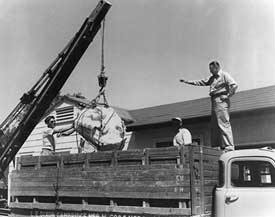
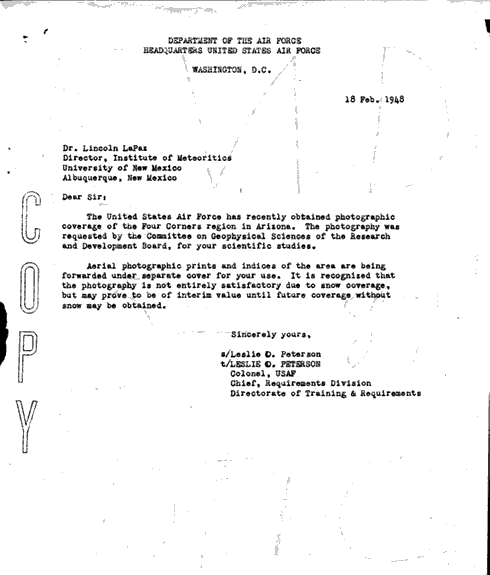
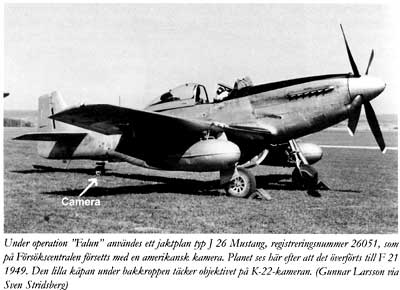
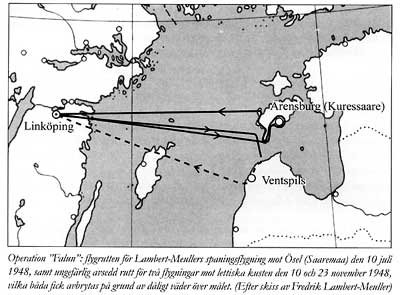
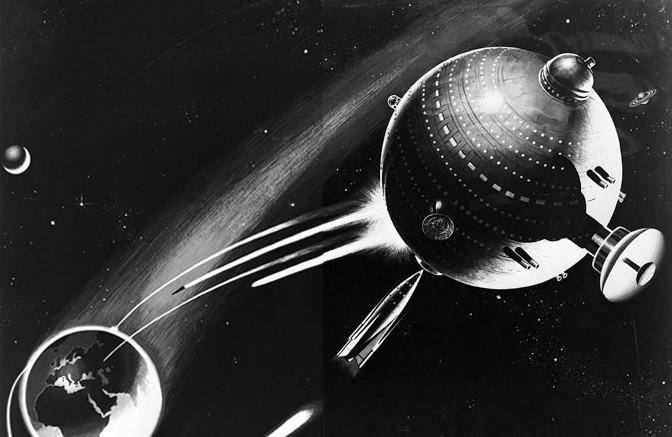
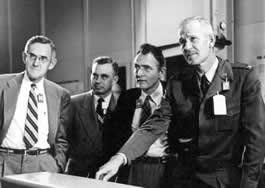
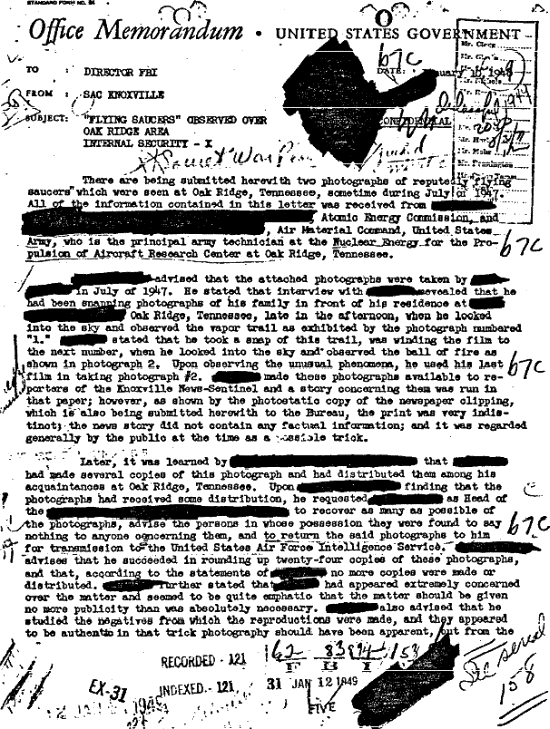
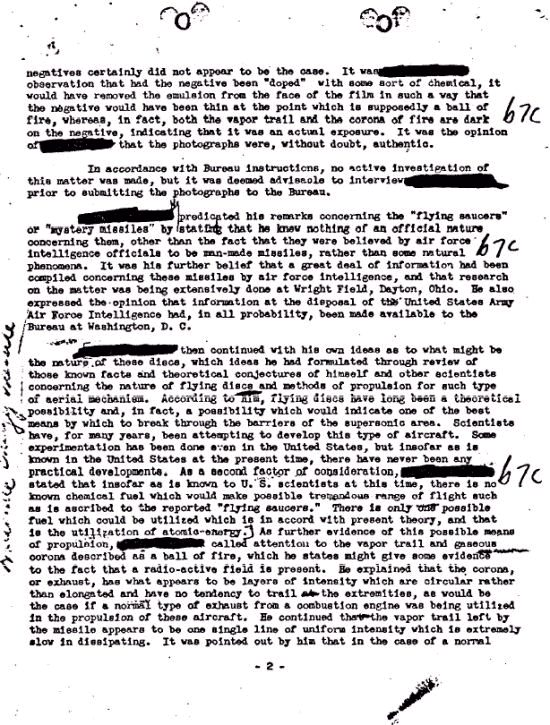
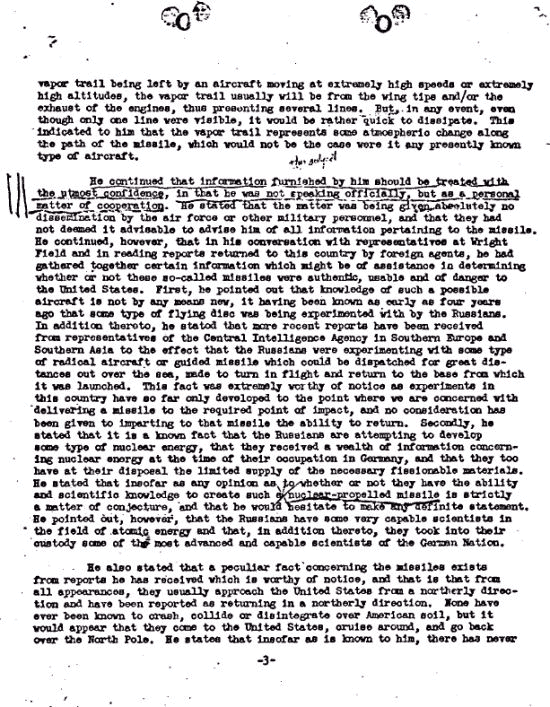
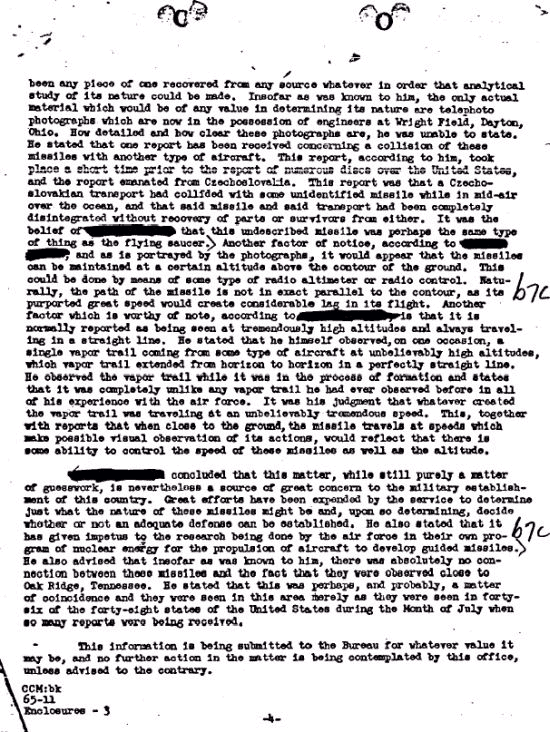
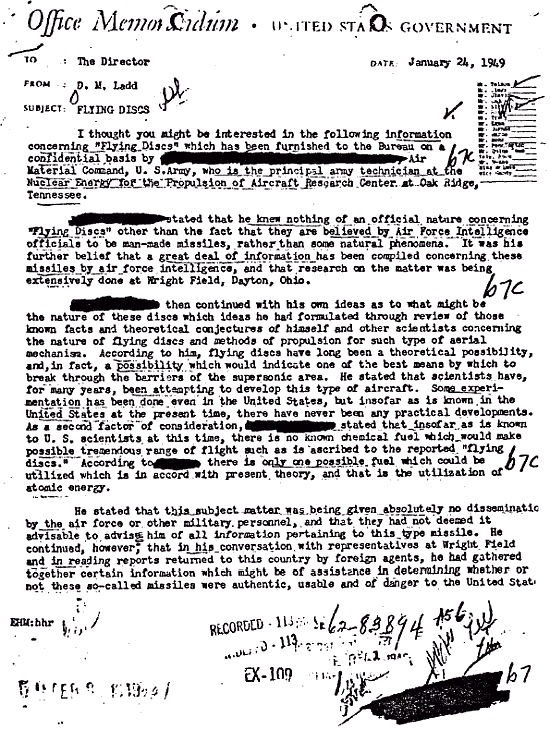


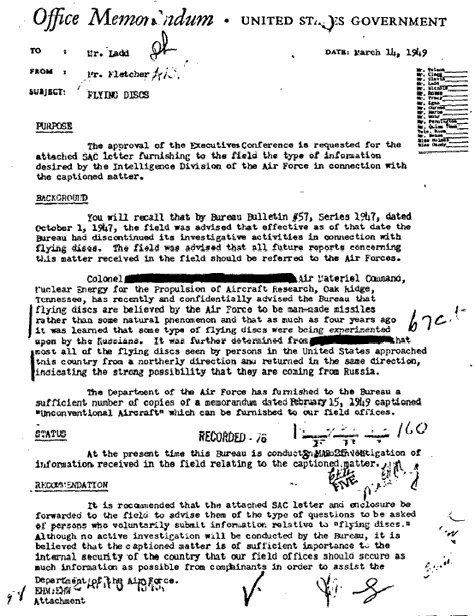
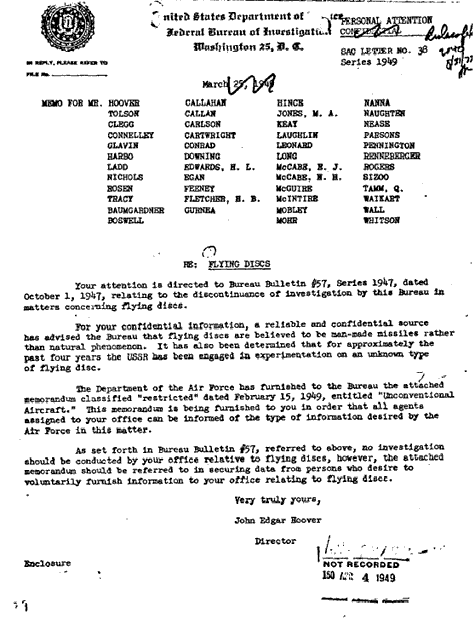
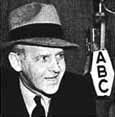
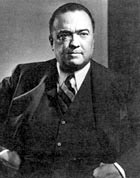
 - Gen C. P. Cabell
- Gen C. P. Cabell